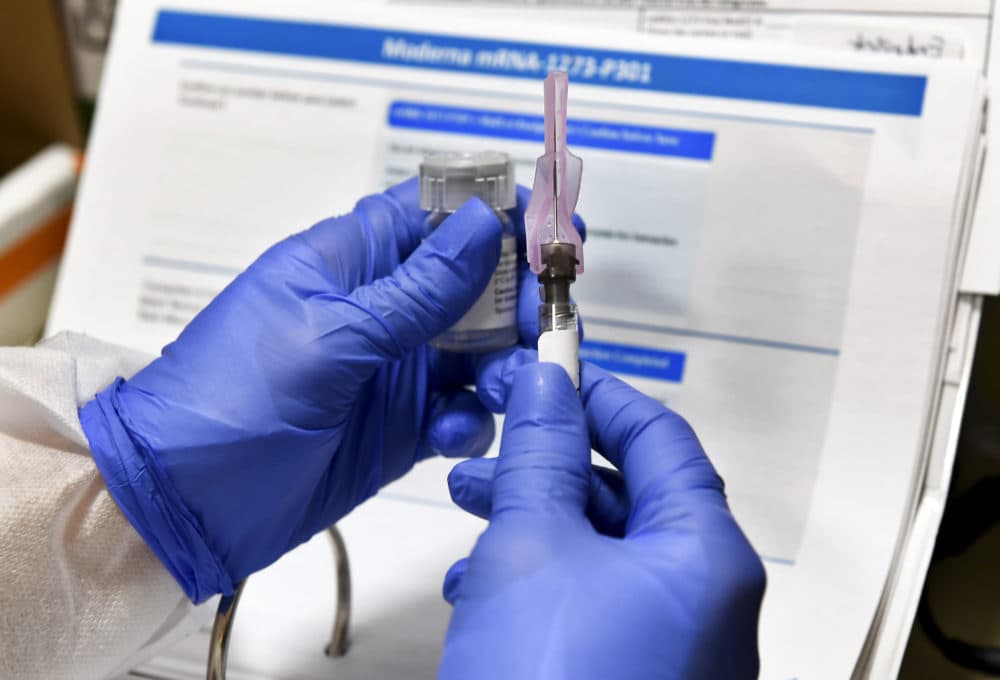Advertisement
Coronavirus Coverage
'It's Like Star Trek': Moderna's Coronavirus Vaccine Moves Toward Approval

Although approval is still not guaranteed, Moderna’s coronavirus vaccine has now cleared by a long shot the hurdles the Food and Drug Administration initially set for emergency use authorization. The agency requires vaccine makers to show at least two months of safety data with no serious negative reactions and at least a 50% efficacy rate.
On Monday, Cambridge-based Moderna announced its phase three clinical trial shows the vaccine has a 94.1% efficacy rate and no significant safety concerns, after two months of study. Dr. Tal Zaks, the company’s chief medical officer, relayed the results to senior staff over a video call in the morning. The staff erupted into applause.
“It’s hard to tell you how exuberant we were,” says Ray Jordan, Moderna's head of corporate affairs. “Most everyone is on mute in a big meeting, and you just start seeing hands moving. Then people started unmuting. It was a big moment. It was just the feeling like, ‘This is making a difference. It may be saving lives.’ ”
Zaks received the company's latest report Sunday night, hours before the senior staff. Speaking to The Associated Press, he said he expected the vaccine to be highly effective at preventing COVID-19, the disease caused by the coronavirus, but he was still moved by the data.
“When I saw the final results last night, I allowed myself to cry for the first time,” he says.
Now, following Pfizer, Moderna has become the second company to file an emergency use application with the FDA for a coronavirus vaccine. An FDA advisory panel is expected to review the applications by mid-December, and Moderna’s Jordan says vaccine distribution may begin before the end of 2020.
“This is a pivotal moment for the program. The work is really ramping up for a number of teams,” Jordan says. “Boy, the manufacturing team is in a spotlight now.”
The biotech is prepared to deliver 20 million doses to the United States in December or early January, as well as another 100 million in 2021. Both Moderna and Pfizer also have contracts with other countries to deliver vaccine doses, and the U.S. government has the option to purchase more of the vaccines. From there, state and federal officials will determine priorities for vaccine distribution. Elders and frontline workers are expected to be highest on the list for receiving the vaccines, which both require two doses.
The basis of the Moderna and Pfizer vaccines is modified mRNA, short for messenger RNA. This is a type of genetic code that instructs cells to build proteins. Moderna and other vaccine makers engineered a piece of mRNA that cells use to construct the spike on the outside of the coronavirus. The body’s immune system uses that viral fragment to build a defense against the virus.
If it receives FDA approval, the coronavirus vaccine will be the first product that Moderna, a relatively small Cambridge biotech firm, has ever brought to market. Over the last year, the COVID-19 pandemic has been a trial by fire for the biotech’s novel mRNA science, a technology that researchers describe as having awesome potential.
“It’s like Star Trek technology,” explains Dr. Benjamin Linas, an epidemiologist at Boston University who is not involved with Moderna’s vaccine work. “We never made vaccines in this way. If they’re working, the potential to rip out new vaccines is incredible. All you do is sequence the virus, come up with the snippet of RNA, and you’re off to the races.”
But mRNA technology can do far more than create vaccines against viruses and bacteria. Simply by changing the RNA code, Moderna’s technology could also be used to create treatments for diseases and infections. In the past, researchers have used the same mRNA technology deployed against the coronavirus to design prototype vaccines against cancer and command mature human cells to turn into stem cells, which can help regenerate tissues and may be key to making irreparable damage — like spinal cord injuries — curable.
Before the pandemic, the company had already begun research on nine different applications for mRNA. Now, buoyed by the apparent successes of its coronavirus vaccine in clinical trials, Moderna is eagerly looking to return to those applications soon — like personalized cancer treatment, heart failure treatment and autoimmune disease treatment. While all hands at the company went to work on the coronavirus vaccine, Jordan says the pandemic has accelerated the rise of mRNA medical technology.
“We do think [the coronavirus vaccine] is a proof of concept. As it turned out for coronavirus, it was a straightforward build to trigger your immune system,” Jordan says. “It proved to be a kind of perfect application for the technology.”
